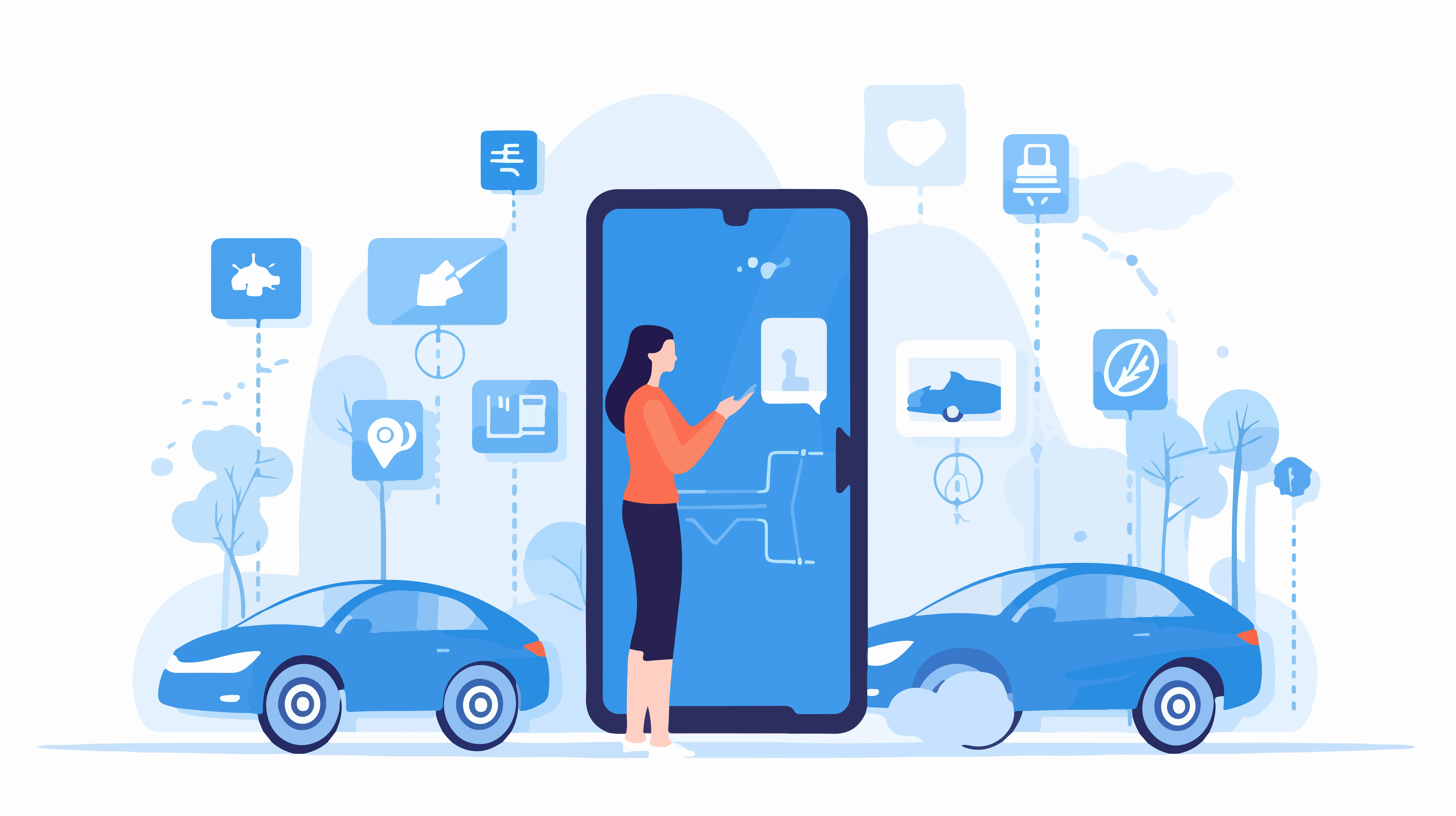Connected car evolution has significantly shifted vehicles from isolated machines into dynamic, data-driven platforms. Initially, car connectivity focused on basic telematics, such as navigation and vehicle tracking. As technology advanced, cars integrated IoT, AI, 5G, and cloud systems, enabling them to communicate beyond internal systems to external networks. This advancement laid the foundation for Vehicle-to-Everything (V2X) communication, allowing cars to connect with other vehicles (V2V), infrastructure (V2I), and pedestrians (V2P).
Today, connected cars prioritize safety, efficiency, and driver convenience. They use real-time data for enhanced navigation, remote diagnostics, and seamless in-car experiences. This transformation has not only improved travel safety but has also created a fully integrated driving environment that paves the way for more autonomous and intelligent mobility solutions. Be sure to mark your calendar for the Digital Revolution in Connected Cars Conference, hosted by World BI! This dynamic event will bring together industry leaders, innovators, and experts who will explore the future of connected vehicles and the vital role communication plays in this transformation
Why Communication is Crucial For a Modern Driving Experience?
Communication plays a crucial role in the modern driving experience, significantly enhancing safety, efficiency, and convenience. With the advent of connected car technology, vehicles can exchange real-time data with each other and surrounding infrastructure, fostering a collaborative ecosystem that minimizes accident risks and optimizes traffic management.
Through effective communication, drivers receive vital updates on road conditions, weather changes, and the best routes to take, improving their situational awareness and enabling better decision-making while driving. Furthermore, connectivity enables advanced functionalities such as remote diagnostics, over-the-air software updates, and personalized settings, which contribute to a smoother and more tailored driving experience. As vehicles evolve towards greater autonomy, robust communication with external systems will be essential for ensuring safe and efficient transportation.
Key Component:
Seamless communication in connected cars relies on several essential components that work in harmony to facilitate effective data exchange and connectivity.
These key components include:
Vehicle-to-Everything (V2X) Technology:
This includes Vehicle-to-Vehicle (V2V), Vehicle-to-Infrastructure (V2I), and Vehicle-to-Pedestrian (V2P) communication. V2X enables vehicles to share information about their surroundings, traffic conditions, and potential hazards, thereby enhancing safety and operational efficiency.
Advanced Communication Protocols:
Reliable communication protocols such as Dedicated Short-Range Communications (DSRC) and Cellular Vehicle-to-Everything (C-V2X) enable high-speed, low-latency data transmission between vehicles and surrounding infrastructure, facilitating real-time updates and interactions.
IoT Integration:

The Internet of Things (IoT) allows connected cars to interact with various devices and systems, including smart traffic signals and other vehicles. This integration forms a comprehensive network that improves overall driving conditions and enhances user experiences.
Cloud Computing:
Cloud platforms support the storage and processing of large amounts of data gathered from vehicles. This capability enables real-time updates, predictive analytics, and personalized services for drivers.
5G Connectivity:
The rollout of 5G networks provides the high-speed and low-latency connectivity necessary for efficient communication among connected vehicles. This enhanced bandwidth supports the rapid transmission of large data sets, facilitating features like real-time decision-making and streaming.
In-Car Communication Systems:
User-friendly interfaces, including voice recognition and touchscreens, enhance driver interaction with connected services. These systems allow drivers to receive alerts, access navigation information, and control vehicle functions without distractions.
Data Security and Privacy Measures:
Safeguarding the data transmitted between vehicles and infrastructure is crucial. Employing encryption, secure authentication methods, and adhering to privacy regulations help protect user information and foster trust in connected car technology.
Artificial Intelligence (AI) and Machine Learning (ML):
AI and ML technologies analyze data from connected cars to improve predictive capabilities and user experiences. They also enable autonomous driving features by making real-time decisions based on available data.
Key Challenges of Seamless Communication in Connected Cars
Seamless communication in connected cars provides numerous advantages but also faces several challenges that can impact its effectiveness and reliability.
Key challenges include:
Data Security and Privacy Risks:
Increased connectivity heightens the potential for data breaches and unauthorized access. Protecting sensitive information, such as personal data and vehicle location, is essential. Implementing strong encryption and security measures is crucial to safeguard against cyber threats.
Interoperability Challenges:
Different manufacturers often utilize various communication protocols and technologies, leading to interoperability issues. It is vital to ensure that vehicles from diverse brands can effectively communicate with one another and with infrastructure to create a cohesive connected car ecosystem.

Latency and Reliability Issues:
Real-time communication is essential for the functions of connected cars. However, factors such as network congestion and signal interference can result in latency, affecting the responsiveness of safety features and other connected services.
Infrastructure Gaps:
The performance of connected car communication is heavily dependent on the availability and quality of supporting infrastructure, such as smart traffic signals and 5G networks. Insufficient infrastructure can limit the effectiveness of V2X communication and the overall advantages of connected technology.
Regulatory Hurdles:
The rapidly evolving nature of connected vehicle technology often outstrips existing regulatory frameworks. Clear guidelines and standards for communication, data sharing, and safety must be established to promote innovation while ensuring public safety.
User Acceptance and Trust Issues:
For connected cars to be widely adopted, users must be willing to embrace the technology. Concerns regarding data privacy, cybersecurity, and the reliability of automated systems can lead to skepticism among consumers.
Complex Data Management:
Connected vehicles generate large volumes of data that require effective management and analysis. Handling this data responsibly, ensuring its accuracy, and using it to improve user experiences without overwhelming drivers pose significant challenges.
Environmental Influences:
Weather conditions, terrain, and urban landscapes can affect communication signals and connectivity. Ensuring reliable communication in diverse environments is critical for the consistent operation of connected car features.
Connected Cars Conferences
Seamless communication is poised to play a pivotal role in shaping the future of connected and autonomous vehicles. By facilitating real-time data exchange between vehicles, infrastructure, and the environment, this communication will significantly enhance safety, efficiency, and overall driving experiences. As cars become more integrated within a sophisticated network, we can anticipate innovations that improve traffic management, reduce accidents, and streamline navigation, all while bringing us closer to realizing fully autonomous driving.
To stay at the forefront of these advancements and understand their implications, it’s essential to remain informed about the latest developments in connected car technology. We invite you to attend the upcoming Connected Cars Conference Digital Revolution in Connected Cars organized by World BI. This event will bring together industry leaders, innovators, and experts to explore the future of connected vehicles and the role of communication in their evolution. Join us to gain valuable insights, network with professionals, and be part of the conversation that is driving the automotive industry forward.